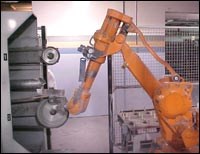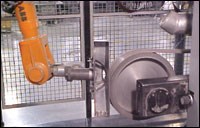Solutions at Work
Robotic polishing cells benefit Kirby Vacuum's process, product and people…
The Kirby Company's implementation of robotic polishing cells has resulted in substantial cost savings, process improvements and enhanced employee positions. Robotic automation has enable the Cleveland, Ohio based vacuum cleaner manufacturer to reduce direct labor costs, decrease abrasive tool costs by 75%, reduce work in process by 50% and increase throughput by more than 20%.
Robotics have given Kirby's employees advancement opportunities, often raising their job classifications, as well as providing them with a safer, cleaner work environment. With the company's in-house capability to perform the polishing process competitively, job security is enhanced, since the threat of outsourcing is eliminated.
For more than 85 years, Kirby, a subsidiary of The Scott Fetzer Company, has produced vacuum cleaners with polished aluminum castings that have been a trademark of the product's quality, reliability and performance. The quality of the product and the company's rebuild program, which provides owners with the ability to have units completely rebuilt at a fraction of the cost of a new cleaner, have earned Kirby products a reputation as a “product for life.”
Kirby's Cleveland Manufacturing plant manager Tony Siracusa explained, “Since polished aluminum castings have been at the forefront of our core competency for more than 85 years, it is essential that we ensure our long-term ability to produce them cost effectively. A number of factors led us to look for alternatives to the manual polishing process that we were using.
“Since manual polishing is a specialized trade, more of an art than a science, it takes six months to a year to train an employee. Although we have been able to retain skilled polishers, the environmentally and physically challenging work has deterred individuals from pursuing the craft. During this time, we also anticipated natural attrition as more Kirby polishers were reaching retirement age.”
Among the other factors that led Kirby to investigate its options was the fact that manual polishing is its most labor-intense operation. The direct labor cost associated with it was high. Ergonomic and industrial hygiene concerns, particularly compliance with the increasingly stringent OSHA requirements for injuries due to repetitive motion such as carpal tunnel syndrome, were also a consideration.
In Search of a Solution
Kirby contracted with General Motors Institute (GMI) to research the viability of robotics for its polishing process. From the study, it learned that using robotics was feasible since it could provide more than three axes of motion, which are required to duplicate the human wrist's flexibility. GMI's investigation also revealed that there was no cost-effective way to interface real-time feedback from the polishing wheel with a processor. Without this connection, consistent part quality could not be maintained during the production process.
Mr. Siracusa reported, “After reviewing GMI's input, we began talking with robotic polishing cell vendors about a turnkey process, since we learned that our existing 30 polishing lathes could not be retrofitted. While we also considered buying robots and putting them in front of each lathe to integrate them, we saw that we would not get the real-time feedback and precision we needed. Although we found vendors who could provide a robotic polishing cell, the integration costs were too great, and we could not justify the cell and meet the project's year-and-a-half payback goal. When we told Pinnacle Technologies' president, Bob Penque, what we needed, he indicated that he could develop a solution that would meet our process needs as well as financial requirements.
“We had worked with Pinnacle Technologies Inc. on other applications, and we knew the company had buffing and polishing expertise, robotics experience as well as an understanding of our business. Since this was our first automated robotic installation, confidence in our vendor was critical. We wanted a long-term relationship and the training, support and technical services of an experienced supplier.”
Leveraging Polishers' Expertise
Polishers were observed as they went through the manual operations. A video was shot so that the robotic programmer could study the polishers' moves. Once a program was developed, Kirby's polishers gave feedback so that the program could be fine-tuned. Since they know how to polish the product, their knowledge and expertise were considered critical to the development of the robotic polishing application.
Communication and Training
Before the robotic polishing cell was developed to meet Kirby's process and financial needs, Kirby began a comprehensive internal communications program to streamline the adaptation of robotics into its facility.
Mr. Siracusa stated, “To minimize management and employee concerns about the impact of robotics, we were open with our workforce. We also established a management philosophy that no one would lose his/her job through robotics or automation. We would handle the reduction in workforce through attrition, and we would be patient through that attrition as we planned to phase in additional robotic systems in anticipation of future attrition.
“Additionally, we began an extensive in-house program to prepare employees for the transition. Not only did we encourage group leaders and supervisors to take company financed classes in robotics, but we also had outside robotics experts train our employees in house.”
Robotics at Work
Kirby's first robotic polishing cell, designed to polish the vacuum cleaners' shells, enabled the company to combine a deburring operation and an abrasive belt polishing operation, both of which had been done manually. In the cell, the robot picks up the piece and goes to one abrasive belt unit to perform the deburring and abrasive belt polishing operations.
The company saw an additional opportunity for optimizing the cell and worked to integrate a drill and tap machine with the polishing cell. Since the cell now performs all three operations, robotic uptime is maximized.
The cell, which was built and preprogrammed at the manufacturer's plant in Italy, includes an ABB IRB 2400/16 kilo robot and a standard size electrical cabinet on a common base with the robot control cabinet. The main electrical cabinet includes an Allen-Bradley Panel view 550 video monitor and keyboard for the operator interface. The monitor displays alarm conditions, inputs and outputs, cycle time and parts count. From the monitor, the operator can set the operating pressure for the abrasive belt force control system, abrasive belt speed, belt pressure increment to compensate for the wear of the abrasive and belt lubricant spray cycle. The cells use a standard base for the robot, magazine and polishing units, which gives users a modular unit that conserves floor space.
Benefits Exceed Expectations
Kirby reported that the performance of its first robotic polishing cell exceeded expectation in reducing direct labor costs, decreasing abrasive tool costs 75%, reducing work in process by 50%, increasing throughput by more than 20% and generating savings from the minimization of factory supplies.
Mr. Siracusa explained, “In addition to the cells’ ability to run 150 parts per belt vs the manual method’s 50 parts per belt, we also gained enhanced quality. Since the robotic polishing is done with a belt that has more parts processed on it, it is like polishing with a finer grit belt. That makes the next process (cut buffing and color buffing) easier because there are fewer polishing lines to remove.”
Although the implementation of the cell eliminated three direct labor operators, it resulted in enhancing employees’ job classifications, as more technical positions were required. Since maintenance roles have become more critical as well as more sophisticated, Kirby supported employee training, which also improved job classifications. The polishers that used to manually work the parts are now operating the robots, and that is a higher job grade. It is a safer, cleaner job. Kirby’s main goal was to maintain this process competitively in-house and avoid outsourcing.
“Robotics also provide us with the kind of flexibility that will keep the process competitive. Unlike fixed automation, robotics gives us the ability to adapt a model or part change quickly with quick-change tooling. We can reprogram the robot and refixture the part and be running in minutes,” stated Mr. Siracusa.
Currently, three robotic polishing cells polish 80% of the parts manufactured at the Cleveland facility. Four additional cells polish 50% of the parts produced in the company’s Andrews, TX operation.
“We try to manage our direct labor costs cautiously so that we can continue to pass on benefits to employees as well as maintain our competitive position,” stated Mr. Siracusa “With robotics, we have been able to meet our productivity and profitability targets as well as demonstrate our long-term commitment to retaining and enhancing employees jobs.”
Related Content
Replacing Open-Top Vapor Degreasing in Aerospace Manufacturing
Options and considerations for cleaning aerospace parts as regulations tighten on vapor degreasing solvents.
Read MoreMicroCare Offers Alternatives to Discontinued Vapor Degreasing Fluids
MicroCare says it is equipped to handle customers affected by 3M's discontinuation of the Novec specialty fluids line with its own products.
Read MoreTop Shop Emphasizes Dedication, Work Ethic
With a primary focus on aerospace and defense work, American Metaseal Corp. of Arbutus, Maryland, has qualified as a Top Shop on multiple occasions.
Read MoreVapor Degreasing Cleaning Fluids for Precision Cleaning
Tergo XCF2 cleaning solution is designed to meet diverse industrial technical cleaning needs with formulas that deliver reliable and repeatable cleaning performance.
Read MoreRead Next
Delivering Increased Benefits to Greenhouse Films
Baystar's Borstar technology is helping customers deliver better, more reliable production methods to greenhouse agriculture.
Read MoreA ‘Clean’ Agenda Offers Unique Presentations in Chicago
The 2024 Parts Cleaning Conference, co-located with the International Manufacturing Technology Show, includes presentations by several speakers who are new to the conference and topics that have not been covered in past editions of this event.
Read MoreEducation Bringing Cleaning to Machining
Debuting new speakers and cleaning technology content during this half-day workshop co-located with IMTS 2024.
Read More
























